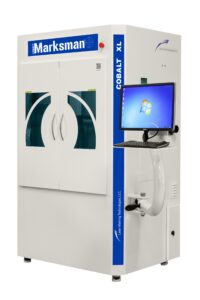Manufacturing firearms that are safe to use requires precision and integrity. One way that the firearms industry has adapted to facilitate safety is by requiring strict gun laser engraving and marking protocols on weapons. Since traceability is another priority in the firearm industry, it’s particularly important that manufacturers find a marking process that’s precise and easy to repeat.
Laser engraving is commonly used to support this mission, making it the number one choice for firearm traceability. If you’re looking for gun laser engraving machines, Laser Marking Technologies is your source for the best warranties on the market and 24/7 support.
Since the Federal Bureau of Alcohol, Tobacco and Firearms (ATF) has specific parameters that must be followed during firearm production, it’s important to find a marking method that easily follows those parameters. Using laser marking systems is a precise way to adhere to those restrictions because of its versatility and consistency. Choosing the incorrect configuration can lead to expensive errors.
Firearm standards are designed to keep the integrity of each firearm intact, making it safe to operate. And following these parameters involves staying within a certain range of height and depth, which is easily attainable with a laser.
Following the regulations outlined by ATF, firearms are required to be identified through specific methods, including:
This list also includes any other conspicuous means of affixing an individual serial number onto the firearm’s frame or receiver. It’s essential that this serial number is placed so that it cannot be easily obliterated, changed, or removed. Additionally, the serial number must be unique and should not duplicate any other serial number that you have previously placed on the firearm to ensure the proper identification and traceability of firearms, which is crucial for regulatory compliance and law enforcement purposes.
In January 2002, the ATF changed the rules for firearms made and imported moving forward. Specific requirements were set regarding the depth and print size for the serial number’s engraving, casting or stamping. The text must be at least 0.003 inches deep, and the print size must be 0.625 inches or larger.
The ATF’s minimum standards ensure all firearms can be identified properly. All new regulations make it easier for them to find and track firearms used to commit crimes.
Firearms require the creation of a serial number to create part traceability. If crimes occur or illegal weapon trading takes place, the serial numbers help officials trace the origins of the weapon. The serial number on a firearm cannot be the same as the serial number on another firearm. Traceability is the ability to monitor the path of an object throughout its journey through a scannable barcode. Since laser engraving creates long-lasting and easily readable text, data matrix codes, and branding graphics, it’s the ideal pick for firearms manufacturing.
Gun engraving technology was developed to fulfill the desire for personalization rather than to meet tracing requirements. Since then, better technology has enhanced the functionality and capabilities of laser marking machines in the firearm sector.
This equipment employs cutting-edge technology and specialized software to achieve detailed engravings. They are equipped with high-speed rotary spindles and advanced laser systems, which utilize vision sensors and barcode reading equipment to confirm serial numbers are accurately labeled, readable, and not duplicated. New machines complete detailed images and simple designs quickly while using MOPA technology and high-quality beam delivery and optical setups tuned specifically to create crisp and efficient depth or contrast. Fiber laser machines offer incredible detail and are compatible with various materials.
You can engrave a firearm to customize it and ease firearm identification by including the name, city and state of the manufacturer, as well as the gun’s model. Place a logo or an intricate design on a weapon. Customers can also choose to personalize their firearms to commemorate special occasions, such as graduations or military service.
Our team provides online training and demonstrations, and all our products are made in the USA at our own in-house facility. Using our gun engraving machines will not affect the firearm’s performance.
ATF also requires information like the manufacturer, location where the firearm is made, the model, caliber, and serial number to be easily accessible on each weapon. While it is possible to mark weapons with stamping or casting processes, engraving delivers high-contrast marks that are more likely to last a lifetime than stamped alternatives.
Laser engraving is commonly used in many different types of products in the firearm industry. During the firearm engraving process, manufacturers commonly engrave accessories, rails, suppressors, barrels, and more.
You can also brand, trace, and decorate weapons, which makes it a great candidate for firearm production. It’s an extremely precise process, which makes it a good candidate for applications that require strict parameters. But what also sets this process apart from others is its ability to maintain material integrity after the material has been marked, which is essential when it comes to weapons.

Engraving has become a major opportunity for manufacturers and retail businesses. No method can compare to laser engraving’s quality and versatility, but you need a robust, precise and purpose-built machine to achieve excellent results. Here at Laser Marking Technologies, clients can meet with experts to fulfill their production needs.
We have over 100 years of experience providing our clients with high-quality laser engravers. When you choose our laser marking machines, you can link to customer databases for immediate communication of completed serial numbers, operator information, and sourcing new variable data to greatly improve your efficiency and reduce costs. Get in touch with us today to ensure that your weapon engraving needs are met, and capable of meeting rigid manufacturing requirements.